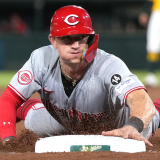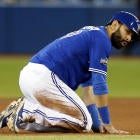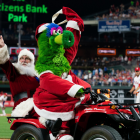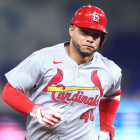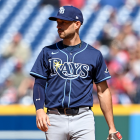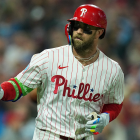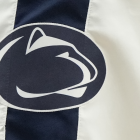
Blue Jays' identity crisis could lead to end of short-lived Toronto renaissance
How the Blue Jays going all-in to win could actually cost them in the long run

Edwin Encarnacion is no longer a Blue Jay. Just before Christmas, Cleveland's baseball team landed the biggest remaining bat on the free-agent market on a three-year, $60 million contract. The deal vexed Jays fans, who wondered how their parrot-toting hero could have bolted for Ohio after being offered four years and $80 million (with the possibility of a fifth-year option that would have been pushed the deal to $100 million) to return to Rogers Centre.
The gut reaction to this chain of events has been to assign blame. Did the Jays misread the market in how they approached Encarnacion and the players they signed when he wouldn't take their money? Or did Encarnacion and his agent Paul Kinzer misread the market by not jumping at Toronto's significantly larger offer?
The answer is both. But while Encarnacion and Kinzer will regret leaving tens of millions of dollars on the table, a look at Jays president Mark Shapiro's track record suggests he might not feel much regret ... if any. The result could be a forgettable season in Toronto -- and maybe a bunch more to come.
The Blue Jays hired Shapiro on Aug. 31, 2015, tapping the former Indians exec to succeed Paul Beeston as the new team president and CEO. One month before that hire, then-Jays general manager Alex Anthopoulos pulled off one of the most aggressive trade deadline shopping sprees in baseball history, reeling in David Price, Troy Tulowitzki, Ben Revere, Mark Lowe and LaTroy Hawkins in a span of 72 hours.
Spurred by those moves (plus some positive regression for a team that had a .500-ish record despite a sky-high run differential), the Jays stormed to their first playoff berth in 22 years, culminating with Jose Bautista's majestic bat flip and that first push to the ALCS. As the team kept winning that fall and into 2016, the city lit up. Fans started selling out the enormous Rogers Centre, with lines queueing up hours before game time for primo giveaways. TV ratings soared. All over the city, bars were packed with fans glued to the screens, decked out in blue and white. A full-on baseball renaissance was in bloom.
None of this was part of Shapiro's plan. He saw an old team (the Jays fielded the fourth-oldest group of position players and sixth-oldest group of pitchers in the majors in 2015) and figured a reckoning would be coming soon. He loathed Anthopoulos' decision to go all in to win in 2015, lamenting the GM trading away a passel of prospects, led by dynamic young pitchers Jeff Hoffman, Daniel Norris and Matt Boyd. Rather than sacrifice young talent to win now, Shapiro wanted to shop key veterans to build for the future. There were rumors that Shapiro would have axed manager John Gibbons at the end of 2015, too, if not for the team's huge surge down the stretch.
Toronto's success scuttled all of that. Rather than tear down the roster, Shapiro and new GM Ross Atkins (who took over after Anthopoulos stepped down rather than play second fiddle to Shapiro) retooled it last winter. One particular sequence of moves pissed off legions of fans, with the Jays letting Price walk, opting instead to sign veterans J.A. Happ and Marco Estrada to shorter, far less expensive deals. That kind of prudence fulfilled Shapiro's goal to avoid overreaching given the age of the roster (the Jays were even older in 2016). It also made plenty of baseball sense. Happ had evolved from punching-bag status in his first tour with the Jays to one of the best lefties in the league with Pittsburgh; Estrada's newfound mastery of high-spin fastballs made him a bargain at two years, $26 million; and Price wasn't worth the $217 million the Red Sox gave him, because pitchers are time bombs, and most big-ticket deals for free-agent pitchers in their 30s end terribly. The Jays rotation actually improved post-Price, Toronto rolled to a second straight playoff berth and again fell just short of the World Series. And it is worth reiterating the comparably tiny price difference on the hitters compared to how big the price gap was on those pitchers.
At first glance, watching Encarnacion sign with a top American League rival and inking a cheaper alternative might seem like a carbon copy of last year's Price vs. Happ-and-Estrada dilemma. But a closer look suggests a front office that's neither pushing to win this year nor executing the rebuild it wants, instead taking half-measures that could land the Jays in a familiar spot: the middle of the pack.
Kendrys Morales isn't going to be as good as Encarnacion over the next three seasons, and there are good reasons to wonder if he'll be any good, period. Unlike Encarnacion, who has shown he can handle first base reasonably well, Morales figures to be a DH-only from now through the end of the 2019 season. He's also painfully slow and thus a major liability on the basepaths; over the past four seasons, only Victor Martinez, Billy Butler and the now-retired David Ortiz have hurt their teams more with their baserunning.
That means that Morales had better absolutely rake to justify his multiyear deal. But while his 30 homers and 93 RBI last season might have helped in some fantasy leagues, his aggregate line of .263/.327/.468 was a more modest 10 percent better than league average on a park-adjusted basis, placing him in the same company as Brad Miller, Cesar Hernandez, Martin Prado and J.T. Realmuto ... except, again, with no complementary skills. Projection systems only see things getting worse from here. Fangraphs' Steamer system accounts for Rogers Centre's friendly confines and forecasts a .265/.331/.468 line in 2017 ... but with Morales playing in just 122 games, a nod to his age. Morales will be 35 in year two of the contract and 36 in year three, so it's hard to imagine anything other than a downhill slope from here.
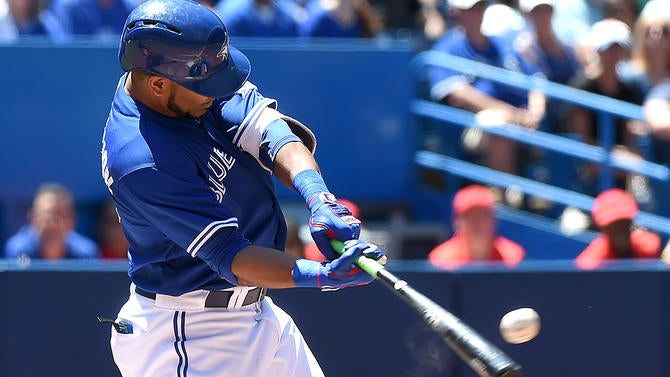
Just before Encarnacion signed with Cleveland, excellent Jays writer Andrew Stoeten walked readers through why Shapiro and Atkins might have opted for Morales over re-signing the fan favorite: draft picks. By letting Encarnacion sign elsewhere, Toronto would gain a compensation pick. By signing Morales, the Jays would avoid losing a pick, which they would have had to surrender if they signed, say, AL home-run champ Mark Trumbo instead. When you're a team committed to building for the future, you can at least try to argue that signing an inferior player for three years makes sense, as long as you come out ahead in draft assets.
Unfortunately, Shapiro and Atkins misread the market. An avalanche of skills-limited sluggers hit the open market this winter. That list included (but was not limited to): Encarnacion, Bautista, Michael Saunders, Trumbo, Carlos Beltran, Matt Holliday, Pedro Alvarez, Mike Napoli, Brandon Moss and Luis Valbuena, as well as lesser options like Adam Lind, Trevor Plouffe, Ryan Howard and Justin Morneau. NL home-run champ Chris Carter would join that list on Nov. 28, after the Brewers declined to tender him a contract. None of that counts multi-talented players like Yoenis Cespedes, Dexter Fowler, Josh Reddick and Carlos Gomez, plus a handful of criminally underrated role players who would wind up signing at discount prices (Matt Joyce, Sean Rodriguez). Other than Cespedes, Fowler and Trumbo (plus Encarnacion and Bautista), none of those players would have required giving up a draft pick. Most also figure to deliver more bang for the buck than Morales at three years, $33 million.
Blame a rigid thought process for all of this. The Jays saw free agency coming for Encarnacion, so they tossed a two-year extension to Justin Smoak as insurance, even though Smoak is the living definition of a replacement-level player. They made Encarnacion a take-it-or-leave-it offer, again fearing they might get left in the lurch ... then weren't able to pivot when a major buyers' market emerged for hitters. When Morales received interest from other teams, the Jays rushed to get him signed just two weeks after the World Series ended, again not trusting that they could find a viable market alternative, in a market flush with them.
So where does that leave the 2017 Blue Jays? With most of the big-ticket free agents (including Encarnacion) off the board and the biggest blockbuster trades likely in our rearview mirror, advanced projection systems have already started handicapping the 2017 season. Toronto's projected record, according to Fangraphs? A supremely middle-of-the-pack 82-80. Projection systems mess up a bunch of course, just as human beings do. But in this case, the gnarly math matches up well with the eye test: The 2017 roster isn't likely to be as good as the 2016 one was.
To be fair, Shapiro and Atkins got thrust into a tough spot. It is hard to sustain success with an aging roster. And while Jays fans will take those two straight thrilling playoff rides any day, it is the case that the farm system thinned out because of go-for-it trades, leaving little hope for impact prospects cracking the majors in the near future. Tearing everything down now would have risked alienating many of the AL-best 3.4 million fans who poured into the stadium in 2016, so maintaining appearances made sense, even if Toronto is now a parrot-free city. But from a pure baseball standpoint, this winter has pushed the team to a frustrating middle ground, where a third straight ALCS trip is spectacularly unlikely, yet the desired rebuild gets delayed.
If Shapiro and Atkins truly wanted to build the team their way, they could have shopped all-world third baseman Josh Donaldson at the height of his value, rather than waiting until, say, the end of the 2017 season, when he'll be one year from free agency. They could have shopped Happ and Estrada coming off big seasons, offering suitors strong and inexpensive starting pitching alternatives at a time when the free-agent market for starters was barren. Trading Tulowitzki might have required eating some of his big contract, but plenty of teams would have vied for a power-hitting shortstop who can still pick it, even at age 32.
Instead, a fetish for future assets, the pressure of fan expectations, the challenges of keeping money flowing and a lot of poor planning adds up to a likely season in limbo. For a franchise that spent two decades mired in mediocrity, that's a pretty lousy thought to start the new year.






